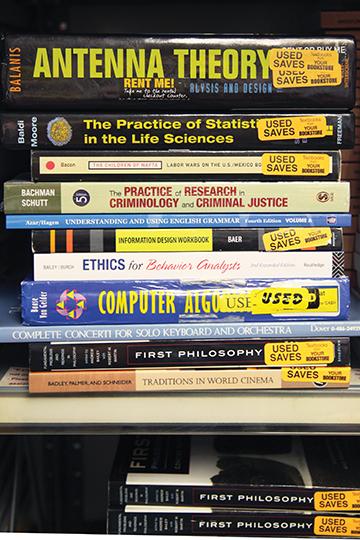The beginning of a new semester, and the scene inside the San Diego State Bookstore is a mad rush of students armed with just their wits and shopping lists, going pale as they mentally calculate the sum total of their purchases before heading to the register.
Two weeks before the official first day of classes, finance senior Jennifer Hunt browsed the stacks in the bookstore, a growing bundle of books in one arm, and in her free hand a shopping list.
Hunt has been through the process a few times, which she has down to a science by now. The first step is to show up early.
“The week before school starts is really chaotic so a lot of the books go fast,” she said.
Cost is the driving factor in her book-buying method, which is why she prefers to buy used or to rent. She shows up early and reserves the books she needs at the bookstore, then checks the bookstore’s price against online competitors such as Amazon.com Inc. For the books she can’t buy cheaper online, she rents at the bookstore. If neither option works, she buys her books new at the bookstore, “as a last resort.”
“I really enjoy renting the books,” she said. “Obviously, I save a lot of money and a lot of the times it’s beneficial because I don’t really need to keep all those books.”
But this semester her priorities are a bit different. She said she won’t be renting because she wants to keep the books that are related to her major.
Sometimes she buys an older edition of a textbook if the professor allows it. This helps because books for business majors can run from $100 to $200, she said.
[quote]
Over 50 percent of the books in the store are used and the average in the country is about 35 percent.
[/quote]
The SDSU Bookstore has the largest print rental program in the country, Aztec Shops Ltd. Director Todd Summer said.
“Over 50 percent of the books in the store are used and the average in the country is about 35 percent,” Summer said.
The California State University launched a program last year that it hopes will mitigate the cost of buying textbooks by allowing students to rent digital copies at steeply discounted prices.
The CSU Rent Digital program launched in Fall 2012 and provided more than 5,000 titles for students to rent for the duration of a semester. This semester, the CSU is planning to expand the program to include 45,000 titles in digital format at a minimum of a 60 percent discount, CSU media relations manager Erik Fallis said.
The CSU started the program in collaboration with several major publishers including Cengage Learning, CourseSmart, Follet, and Barnes & Noble.
“One of our biggest concerns is students who go without textbooks,” Fallis said. Students who forgo buying textbooks for their classes tend to do worse than their peers, Fallis said.
Still, whether or not programs such as Rent Digital can be viable for a large part of the student population remains to be seen.
[quote]
I’m looking at the computer so much anyway…I personally like physical books.
[/quote]
After the program launched last year, the CSU estimated it saved students around $1.5 million altogether. That number is a fraction of 1 percent of the $400 million the CSU estimates its students spend on books each year, Fallis explained.
In the future, digital books might hold more appeal as they become more sophisticated as a multimedia package, which combine text with 3-D visual renderings, sharing and adaptiveness to individual’s needs, Summer said.
For students such as Hunt, who want to keep their textbooks or just prefer a physical copy, digital might prove a hard sell.
“I’m looking at the computer so much anyway, I don’t want to have to be restricted to only the computer,” Hunt said. “I personally like physical books.”







